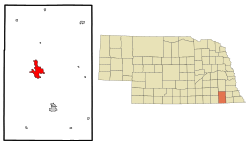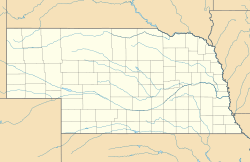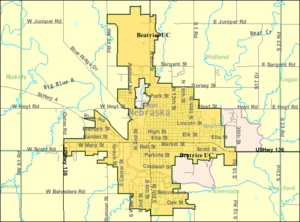Beatrice, Nebraska facts for kids
Quick facts for kids
Beatrice, Nebraska
|
|
|---|---|

Gage County Courthouse
|
|
 |
|
| Country | |
| State | |
| County | Gage |
| Government | |
| • Type | Mayor-council government |
| Area | |
| • Total | 9.56 sq mi (24.76 km2) |
| • Land | 9.48 sq mi (24.55 km2) |
| • Water | 0.08 sq mi (0.22 km2) |
| Elevation | 1,312 ft (400 m) |
| Population
(2020)
|
|
| • Total | 12,261 |
| • Density | 1,293.76/sq mi (499.51/km2) |
| Time zone | UTC-6 (Central (CST)) |
| • Summer (DST) | UTC-5 (CDT) |
| ZIP code |
68310
|
| Area code(s) | 402 |
| FIPS code | 31-03390 |
| GNIS feature ID | 0837869 |
| U.S. Routes | |
| Website | beatrice.ne.gov |
Beatrice is a city in Nebraska, United States. It is the main city and government center, known as the county seat, of Gage County. In 2020, about 12,261 people lived there. This makes Beatrice the 15th largest city in Nebraska. The city is located about 42 miles south of Lincoln, right by the Big Blue River.
Contents
Discovering Beatrice's Past
How Beatrice Began
In 1854, Nebraska was still a territory, not yet a state. The government created 19 counties, including Gage County. At that time, no one lived in Gage County.
In 1857, a steamboat called Hannibal was traveling up the Missouri River. It got stuck near Kansas City, Missouri. On board, 35 passengers decided to form a group called the "Nebraska Association." Their goal was to find a good spot to build a new town.
After reaching Nebraska City, Nebraska, the group split up. One part went west, and the other went southwest. The southwest group found the perfect spot for Beatrice. It was where the DeRoin Trail crossed the Big Blue River. The whole Association agreed to settle there. They named the new town after Julia Beatrice Kinney, who was 17 years old and the daughter of one of the group members.
Beatrice as the County Seat
The government of the Nebraska Territory chose Beatrice to be the county seat of Gage County in 1857. This meant it would be the main city for government activities. Another town, Blue Springs, tried to challenge this decision. However, the government confirmed Beatrice as the county seat in 1859.
Later, in 1864, a county called Clay County was dissolved. Its land was split between Gage and Lancaster Counties. This made Gage County larger and placed Beatrice closer to its center. This helped Beatrice keep its role as the county seat, which it still is today.
The Homestead Act and Its Impact
In 1862, the U.S. Congress passed the Homestead Act. This important law allowed settlers to claim 160 acres (about 65 hectares) of government land for a small fee. The law started on January 1, 1863.
Just after midnight on that day, a man named Daniel Freeman convinced a clerk to open the local Land Office. He wanted to be the first to file a claim for a homestead. His claim was for land about 4 miles (6.4 km) west of Beatrice. Many other people also filed claims that day.
In 1936, Congress created the Homestead National Monument of America on the land where Daniel Freeman made his claim. This monument honors the history of homesteading in America.
Early Growth of Beatrice
The Big Blue River was very important for Beatrice's early growth. It gave the town water and power for mills, which were some of the first businesses. However, the river also caused problems. It was a big obstacle for travelers on the Oregon Trail. Floods often destroyed dams and bridges. It wasn't until 1890 that a strong bridge was built over the Big Blue River in Beatrice that lasted for many years.
Transportation improved with railroads. In 1871, the Burlington and Missouri River Railroad built a line from Lincoln, Nebraska to Beatrice. Then, in 1879, the Union Pacific Railroad connected Beatrice to Marysville, Kansas. By 1890, the Chicago, Rock Island and Pacific Railroad also had tracks running through the city.
A famous person, William McKinley, who later became president of the United States, gave a speech in Beatrice on August 3, 1892. At that time, he was the governor of Ohio.
The company Beatrice Foods was started in Beatrice in 1894. It was first called The Beatrice Creamery Company. It was founded by George Everett Haskell and William W. Bosworth. This company grew to become a large international food business.
Beatrice State Developmental Center
In 1885, the Nebraska government decided to build a special institution near Beatrice. It was for young people with developmental disabilities. Beatrice donated 40 acres (16 hectares) of land for it, about 2 miles (3.2 km) east of the city. The first residents moved in during 1887.
Over the years, this institution grew a lot. By 1935, there were 1171 residents living on 519 acres (210 hectares). The institution had its own farm where residents helped with the work. In 1935, 346 acres (140 hectares) were used for farming.
In 1945, the institution's name changed to the Beatrice State Home. The number of residents reached its highest point, about 2300, in the late 1960s. After that, the number started to go down. New rules limited unpaid work by residents. Also, there was a national trend to move people from large institutions into smaller, community-based care.
In 1975, a lawsuit led to many residents being moved to community-based mental health facilities. That same year, the institution's name changed again to the Beatrice State Developmental Center, which it is still called today.
Beatrice's Location and Weather
Where is Beatrice Located?
Beatrice is located at coordinates 40°16′6″N 96°44′35″W. According to the United States Census Bureau, the city covers a total area of about 9.11 square miles (23.59 square kilometers). Most of this area, about 9.02 square miles (23.36 square kilometers), is land. A small part, about 0.09 square miles (0.23 square kilometers), is water.
What is Beatrice's Climate Like?
Beatrice experiences a climate with warm summers and cold winters. Here's a look at the average temperatures and precipitation:
| Climate data for Beatrice, Nebraska (1991-2020) | |||||||||||||
|---|---|---|---|---|---|---|---|---|---|---|---|---|---|
| Month | Jan | Feb | Mar | Apr | May | Jun | Jul | Aug | Sep | Oct | Nov | Dec | Year |
| Mean daily maximum °F (°C) | 34.9 (1.6) |
40.0 (4.4) |
52.3 (11.3) |
63.3 (17.4) |
73.5 (23.1) |
83.7 (28.7) |
88.4 (31.3) |
86.3 (30.2) |
79.4 (26.3) |
66.6 (19.2) |
51.2 (10.7) |
39.0 (3.9) |
63.2 (17.3) |
| Daily mean °F (°C) | 24.2 (−4.3) |
28.5 (−1.9) |
39.8 (4.3) |
50.5 (10.3) |
61.9 (16.6) |
72.5 (22.5) |
77.0 (25.0) |
74.6 (23.7) |
66.3 (19.1) |
53.5 (11.9) |
39.3 (4.1) |
28.4 (−2.0) |
51.4 (10.8) |
| Mean daily minimum °F (°C) | 13.5 (−10.3) |
16.9 (−8.4) |
27.4 (−2.6) |
37.7 (3.2) |
50.2 (10.1) |
61.3 (16.3) |
65.5 (18.6) |
63.0 (17.2) |
53.3 (11.8) |
40.4 (4.7) |
27.4 (−2.6) |
17.8 (−7.9) |
39.5 (4.2) |
| Average precipitation inches (mm) | 0.69 (18) |
0.90 (23) |
1.73 (44) |
2.88 (73) |
5.05 (128) |
4.60 (117) |
4.06 (103) |
3.77 (96) |
2.99 (76) |
2.33 (59) |
1.32 (34) |
0.98 (25) |
31.3 (796) |
| Average snowfall inches (cm) | 6.4 (16) |
4.9 (12) |
2.2 (5.6) |
0.9 (2.3) |
0.0 (0.0) |
0.0 (0.0) |
0.0 (0.0) |
0.0 (0.0) |
0.0 (0.0) |
0.4 (1.0) |
1.0 (2.5) |
3.0 (7.6) |
18.8 (47) |
| Average extreme snow depth inches (cm) | 5 (13) |
4 (10) |
2 (5.1) |
1 (2.5) |
0 (0) |
0 (0) |
0 (0) |
0 (0) |
0 (0) |
0 (0) |
1 (2.5) |
3 (7.6) |
5 (13) |
| Average precipitation days (≥ 0.01 in) | 4.4 | 4.7 | 6.5 | 9.2 | 11.2 | 9.5 | 9.1 | 8.6 | 7.0 | 6.3 | 4.7 | 4.3 | 85.5 |
| Average snowy days (≥ 0.01 in) | 3 | 2.9 | 1.2 | 0.3 | 0 | 0 | 0 | 0 | 0 | 0.2 | 0.8 | 2.3 | 10.7 |
| Source: NOAA | |||||||||||||
Who Lives in Beatrice?
Population Changes Over Time
Beatrice has seen its population change over the years. Here's a quick look at how many people have lived in the city since 1880:
| Historical population | |||
|---|---|---|---|
| Census | Pop. | %± | |
| 1880 | 2,447 | — | |
| 1890 | 13,836 | 465.4% | |
| 1900 | 7,875 | −43.1% | |
| 1910 | 9,356 | 18.8% | |
| 1920 | 9,664 | 3.3% | |
| 1930 | 10,297 | 6.6% | |
| 1940 | 10,883 | 5.7% | |
| 1950 | 11,813 | 8.5% | |
| 1960 | 12,132 | 2.7% | |
| 1970 | 12,389 | 2.1% | |
| 1980 | 12,891 | 4.1% | |
| 1990 | 12,354 | −4.2% | |
| 2000 | 12,496 | 1.1% | |
| 2010 | 12,459 | −0.3% | |
| 2020 | 12,261 | −1.6% | |
| U.S. Decennial Census | |||
Beatrice in 2020: A Snapshot
The 2020 United States census counted 12,261 people living in Beatrice. There were 5,550 households and 2,907 families. The city had about 1,293 people per square mile (499.4 per square kilometer).
Most residents, about 91.59%, were white. Other groups included 1.04% black or African-American, 0.55% Native American, and 0.73% Asian. About 4.9% of people were from two or more races. People of Hispanic or Latino background made up 2.0% of the population.
About 20.6% of households had children under 18. Many households (39.4%) were married couples. About 41.5% of households were individuals living alone. The average household had 2.1 people, and the average family had 2.8 people.
The median age in Beatrice was 45.0 years. About 20.3% of the population was under 18. About 23.0% were 65 years or older.
Beatrice in 2010: A Look Back
In the census of 2010, Beatrice had 12,459 people. There were 5,509 households and 3,296 families. The population density was about 1,381 people per square mile (533 per square kilometer).
The racial makeup was mostly White (96.1%). Other groups included African American (0.5%), Native American (0.5%), and Asian (0.6%). About 2.2% of the population was Hispanic or Latino.
About 27.6% of households had children under 18. Many households (44.9%) were married couples. About 34.5% of all households were people living alone. The average household size was 2.23 people, and the average family size was 2.82 people.
The median age in 2010 was 42.6 years. About 22.6% of residents were under 18. About 20.4% were 65 years or older.
Fun Places to Visit in Beatrice
Beatrice offers several interesting places for visitors and residents:
- Beatrice Speedway: A place for exciting racing events.
- Gage County Museum: Located in the old 1906 Burlington Railroad Depot. It tells the story of Gage County's history.
- Homestead National Monument of America: This national park honors the first homestead claim in the U.S.
- Homestead Trail: A trail for walking, biking, and enjoying nature.
- Community Players Theatre: A local theater where you can watch plays and performances.
Famous People from Beatrice
Many notable individuals have connections to Beatrice:
- George D. Baker (1868–1933), a director of silent films.
- Eudora Stone Bumstead (1860–1892), a poet and writer of hymns.
- Cam Jurgens, an NFL player for the Philadelphia Eagles.
- Clara Bewick Colby (1846–1916), an author.
- Gene L. Coon (1924–1973), a screenwriter and TV producer.
- Jim Faulkner (1899–1962), a baseball player.
- John P. Fulton (1902–1966), a special effects supervisor for movies.
- Jim Gillette (born 1967), a rock musician and lead singer.
- Homestead Harmonizers, a singing group formed in 1988.
- Peter Jansen (1852–1923), a sheep rancher and Nebraska state politician.
- Weldon Kees (1914–1955), a poet, critic, and novelist.
- Oliver Kirk (1884–1960), who won two gold medals in boxing at the 1904 Summer Olympics.
- Lou Ann Linehan (born 1955), a member of the Nebraska Legislature.
- Kevin Meyer (born 1956), a former Lieutenant Governor of Alaska.
- Xavier Omon (born 1985), an NFL football player.
- Algernon Paddock (1830–1897), a U.S. Senator from Nebraska.
- Pid Purdy (1904–1951), an athlete who played both Major League Baseball and National League football.
- Janet Shaw (1919–2001), a film actress.
- Robert Taylor (1911–1969), a famous film and television actor.
- Edward Wight Washburn (1881–1934), a chemist.
- Dora V. Wheelock (1847–1923), a writer and activist for temperance.
See also
 In Spanish: Beatrice (Nebraska) para niños
In Spanish: Beatrice (Nebraska) para niños





